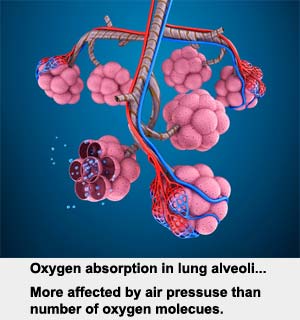

Most of this website is devoted to the Physics of Baseball; how and why the pitched baseball will react while traveling through different weights (or densities) of air resistance. However, there is a subject that is often discussed which tends to confuse performance and muddy the statistical water of baseball.
This confusion also extends into the voting ranks of the Hall of Fame. Some players are overlooked due to physics no one can control and others are granted Hall of Fame status, because they pitched in favorable environments over which neither they, nor anyone else had any control. Of course, the Hall of Fame voters have no way in which to separate the enhanced performance from the inhibited by environmental factors (unless, of course, they begin to use the ADI and VMI within their analysis).
How much of the observed performance was due to these factors of additional ball movement here, versus lack of ball movement there?
 The basics of altitude physiology are as follows: When people, or even animals migrate from a lower altitude to a substantially higher one, it takes approximately 6 weeks for the body to fully acclimate. The acclimation process is three-fold. One is the oxygen level in the blood (cardiovascular system). The second is the oxygen level in the brain (nervous system) and third is the pulmonary system (the lungs).
The basics of altitude physiology are as follows: When people, or even animals migrate from a lower altitude to a substantially higher one, it takes approximately 6 weeks for the body to fully acclimate. The acclimation process is three-fold. One is the oxygen level in the blood (cardiovascular system). The second is the oxygen level in the brain (nervous system) and third is the pulmonary system (the lungs).
One of the first misunderstandings is that there is too little oxygen in the air, causing an acclimation to take place. This does not make scientific sense and borders on what people commonly refer to as "an old wives' tale." Why does it not make sense? Because, at 5,000 feet elevation, there are approximately 11 quintillion (11,000,000,000,000,000,000) molecules of air (including oxygen) in a space only slightly larger than a baseball. So, there are approximately 33 quintillion molecules at full lung capacity in one lung alone. Since the human body absorbes (or uses) only 5% of the available oxygen into the blood stream with each breath, the balance being expelled during exhale, then the issue that causes acclimation to be necessary is not available oxygen, but most likely atmospheric pressure.
 To further illustrate; at sea-level in comparison, there are approximately 13 quintillion molecules of air in the same volume (you do the math) as in the example above and therefore 39 quintillion molecules in a lung approximately 3 times the size of a baseball. When animals or humans migrate to a high altitude from a substantially lower altitude much closer to sea level, the first severe symptom is altitude sickness that occurs at about 8,000 feet elevation. This is caused by brain swelling, due to the lack of atmospheric pressure to which the brain is normally conformed. Altitude Sickness causes brain swelling, dizziness, nausea, and with strenuous activity--pulmonary edema--and can be fatal. See the article on altitude sickness: https://www.uchealth.org/today/2017/12/15/altitude-sickness The only quick cure is to immediately expose oneself artificially in a pressure container, or naturally by descending into additional pressure conditions below 8,000 feet elevation.
To further illustrate; at sea-level in comparison, there are approximately 13 quintillion molecules of air in the same volume (you do the math) as in the example above and therefore 39 quintillion molecules in a lung approximately 3 times the size of a baseball. When animals or humans migrate to a high altitude from a substantially lower altitude much closer to sea level, the first severe symptom is altitude sickness that occurs at about 8,000 feet elevation. This is caused by brain swelling, due to the lack of atmospheric pressure to which the brain is normally conformed. Altitude Sickness causes brain swelling, dizziness, nausea, and with strenuous activity--pulmonary edema--and can be fatal. See the article on altitude sickness: https://www.uchealth.org/today/2017/12/15/altitude-sickness The only quick cure is to immediately expose oneself artificially in a pressure container, or naturally by descending into additional pressure conditions below 8,000 feet elevation.
Blood acclimation takes longer to occur, therefore baseball players who do not live at higher altitudes during the season, nor during the off-season, may not become fully acclimated to higher altitudes even if the home stadium is located at say Denver, Colorado. Studies are on-going regarding incremental altitude effects in lesser than 8,000 feet elevation, but to my knowledge no absolute scientific evidence of performance inhibitors are fully documented and accepted by the American Medical Association at this time.
Since there is not enough air pressure to press the available oxygen inside the lungs against the alveoli membrane to pass into the blood stream, then lesser oxygen initially enters the blood stream and therefore less oxygen gets to the brain. The initial bodily response at a higher than normal elevation is for one to breathe harder with the lung muscles which presses the oxygen harder against the alveoli membranes. The act of breathing harder most likely builds some additional strength in those muscles which surround the lungs and affect the process of breathing for those high-altitude residents.
 The second bodily response is for the bone marrow to produce additional red blood cells, and release them into the blood stream to help carry additional oxygen from that content which is available. The six weeks acclimation period is primarily for the creation of additional blood cells. Once additional blood cells are formed, then athletes become more competive in the higher pressure low altitudes because there is more oxygen attaching to more blood cells making physical performance more relaxed than within their higher altitude venues. This is the reason for the physiological theory of most productive athletic training known as "Live High; Train Low." See article in New York Times https://www.nytimes.com/1998/10/27/science/live-high-train-low-and-move-faster.html. The concept was originally based on the knowledge of Kenyan distance runners who live at approximately 8,000 feet elevation and dominate world class distance running at much lower elevations. It is also the basis for the invention of the Oxygen Depletion Tents in about 1998, in which an athlete would sleep in a tent with nitrogen being pumped into the tent forcing oxygen out (see our page labeled "Air Weight") thereby presuming the body would adjust naturally to oxygen depletion by producing additional red blood cells to compensate. I have not seen complete data on this concept, but if it has received less than stellar results, it is my opinion that it may be because the trigger to producing additional red blood cells is not the lack of oxygen, but the lack of air pressure. It is certainly much less expensive to build a nitrogen tent for purposes of a patent than to create barometric pressurization within a very strong enclosure, which may have had something to do with the Oxygen Depletion Tents' creation in the first place.
The second bodily response is for the bone marrow to produce additional red blood cells, and release them into the blood stream to help carry additional oxygen from that content which is available. The six weeks acclimation period is primarily for the creation of additional blood cells. Once additional blood cells are formed, then athletes become more competive in the higher pressure low altitudes because there is more oxygen attaching to more blood cells making physical performance more relaxed than within their higher altitude venues. This is the reason for the physiological theory of most productive athletic training known as "Live High; Train Low." See article in New York Times https://www.nytimes.com/1998/10/27/science/live-high-train-low-and-move-faster.html. The concept was originally based on the knowledge of Kenyan distance runners who live at approximately 8,000 feet elevation and dominate world class distance running at much lower elevations. It is also the basis for the invention of the Oxygen Depletion Tents in about 1998, in which an athlete would sleep in a tent with nitrogen being pumped into the tent forcing oxygen out (see our page labeled "Air Weight") thereby presuming the body would adjust naturally to oxygen depletion by producing additional red blood cells to compensate. I have not seen complete data on this concept, but if it has received less than stellar results, it is my opinion that it may be because the trigger to producing additional red blood cells is not the lack of oxygen, but the lack of air pressure. It is certainly much less expensive to build a nitrogen tent for purposes of a patent than to create barometric pressurization within a very strong enclosure, which may have had something to do with the Oxygen Depletion Tents' creation in the first place.
In the case of baseball production, we know from recent history that all the higher altitude teams (from 500 feet or above) struggle to compete for championships in the MLB. We also know that statistics indicate high altitude teams perform better at home than at lower altitude locations. We also know that lesser air resistance produces lesser movement for pitchers and it follows that lesser movement on pitches allows hitters more success. Statistics produced in MLB and displayed on this website, when aligned with the air densities in which the performance took place, show clearly that where good ball movement exists, there you will see lesser hitter production over the course of a season. So the physics of ball movement versus production gauged by air density is consistent with air pressure and with the physiological advice to "Live High: Train Low," best conditioning for stamina and performance. But what about the consistency of physiological theories in baseball versus other sports; and versus Live High: Train Low?
There are reports that some sports physiologists are studying a theory that essentially says that playing a homestand of baseball in a home stadium at high altitude reduces the stamina and strength of the player to a level that when that player transitions from high altitude to low altitudes, his strength is depleted enough that he and all his teammates can no longer perform typical baseball activities at a level to compete with home teams. This is not consistent with Live High: Train Low concepts. It is also inconsistent with other sports teams' performance, such as the Denver Broncos Football; University of Denver Hockey and LaCrosse. It is inconsistent with The United States Olympic Committee and Training Centers in Colorado Springs, CO and inconsistent with the results in distance running at Adams State University in Alamosa, Colorado, as well as the same sports at the University of Colorado in Boulder, as well as, the Kenyan distance runners we've already pointed out.
 Other sports do seem to be affected in terms of performance differences between home at high altitude and road trip production at sea level locations, but these are all sports which utilize a projectile free-flying through the air to score points as a substantial portion of the scoring. Three Point shooting in basketball, tennis, soccer (corner kick) golf, and field goal kicking in football, etc. all have that air resistance component that is undeniable. But physiology in baseball is an extreme departure, because of the elapsed time between bursts of speed in the normal performance of professional baseball. When dissecting a complete high scoring game of baseball and laying out all the bursts of speed by the players, except for the pitcher and the catcher, it appears that when considering approximately 4 to 5 seconds between bases; 3 to 5 seconds in outfielder bursts; and all other activities including a two hour warm-up period, the most active players accumulated exertion-time is less than 2 minutes per game. This exertion-time includes the exertion of swinging an approximate 38 oz. bat when missing, as well as, when hitting a baseball.
Other sports do seem to be affected in terms of performance differences between home at high altitude and road trip production at sea level locations, but these are all sports which utilize a projectile free-flying through the air to score points as a substantial portion of the scoring. Three Point shooting in basketball, tennis, soccer (corner kick) golf, and field goal kicking in football, etc. all have that air resistance component that is undeniable. But physiology in baseball is an extreme departure, because of the elapsed time between bursts of speed in the normal performance of professional baseball. When dissecting a complete high scoring game of baseball and laying out all the bursts of speed by the players, except for the pitcher and the catcher, it appears that when considering approximately 4 to 5 seconds between bases; 3 to 5 seconds in outfielder bursts; and all other activities including a two hour warm-up period, the most active players accumulated exertion-time is less than 2 minutes per game. This exertion-time includes the exertion of swinging an approximate 38 oz. bat when missing, as well as, when hitting a baseball.
When further considering that these athletes regularly train to lift 200 pounds and more, for 10 to 20 minutes per work-out, plus additional bodily weight and work-out training; the approximately 2-1/2 pound bat swung for less than 2 minutes per game would not logically add a significant amount of work to fit well with any theory of exertion to substantial depletion, due to any altitude less than 8,000 feet. So this too, appears to be inconsistent with all known scientific knowledge of those who are acclimated to 500 feet and above in elevation for sports participation. Five Hundred feet has never been considered a significant biological detriment, yet our data shows that 500 feet is significant (when combined with temperature variations) and, when baseball pitch trajectory to the plate is part of the equation.
Since we are discussing physiology, then we must acknowledge that there are some individuals who react to high altitude exertion differently than those who do not have any known anemias. For example; football players who carry the sickle-cell anemia must not participate in football in Denver, Colorado as it may be life threatening. See article: https://www.foxsports.com/nfl/story/pittsburgh-steelers-ryan-clark-sickle-cell-trait-scare-an-anomaly-010512
These conditions are rare and there are no known players in Major League Baseball who fit in this category. Also, baseball is not considered a high exertion sport for any length of time beyond the occasional bursts, which can cause injury, but normally not over-exertion.

When teams in MLB first arrive in Denver, CO at 5,200 feet in altitude, to play against the Colorado Rockies, they have arrived from an altitude of less than 1,200 feet and most from below 700 feet elevation where there is no evidence of any oxygen or air pressure deprivation. Within 24 hours of arrival, the teams accumulatively lose over 60% of their games against the Denver home team. This fact would lead some to wonder if there is a physiological or biological reason for such a record against a Denver team that can seldom win more than 40% of their games elsewhere, let alone more than 40% of their first games away from Coors Field.
Visiting teams to Coors Field consistently lose when they first leave Colorado and arrive at any other location, as well. Even if they return to their home stadium. The statistics are staggering. Both scenarios generate less than 40% historical winning percentages in the first game away from Coors Field and extremely similar to the Colorado home team's historical record under the same scenario. Both are historically record lows.
However, if we dig a little deeper, there is another anomaly. Even though these teams lose a very high percentage of their games, the same visiting teams to Coors Field in Denver produce an extremely high number of hits and runs scored on their very first day of performance. With the overall average for away teams in MLB being a hit per strike thrown of 9.16%; the average for teams first arriving at Coors Field is 12.15% strongly suggesting that it is not from a physiological deprivation, but a thin air lack of pitch-movement causation.
High altitude teams tend to perform well in all the high altitude locations, suggesting that there is no deprivation in terms of physiological effects of regularly performing at high altitude. This would make sense, since the players would normally have had more than six weeks to acclimate physiologically.
There are many high-altitude college teams who play against other high altitude college teams and even more high school teams whose schedules compare similarly. There is no indication of any physiological interference with performance.
Interestingly, (at least to me) there is a great indication that these teams conform to their environment for baseball and perform as any other team within its own environment, producing similar game numbers to low altitude teams. This makes total sense if assuming a physics adjustment, but not a physiological adjustment. A physics adjustment, means that the player who is attempting to strike the middle of the free-flying ball with the bat by the swinging action of the arms, is only swinging at what he/she sees and at that which he has been seeing the previous days, weeks' or months. If there has been no need to change his mechanics in order to hit the baseball squarely, then he will continue to swing lower to hit a lesser moving fastball at high altitude and, if he plays at a lower altitude, will continue to swing higher on a four-seam fastball pitch with more movement at sea level, purely because that is what his eyes show him/her to do. This would strongly suggest that the pitch trajectory the eye sees to hit does, in fact, set the muscle memory to an environmentally induced stabilization.

It appears that there is a lot of over-thinking of the issue. Most of those who care anything about this subject already know that the football field goal kick and the golf ball travel further in higher altitude locations from lack of air resistance. Why would the baseball be any different? We already know that home-runs travel further in the thin air of Colorado. Why would the pitched baseball react any differently than less air resistance would dictate? If we know this, then why would it be necessary to continue to try to come up with some additional voo-doo to explain what we already know? Well - there is an explanation for this, too. Money and Fame! Money comes in all kinds of forms in our society from government grants for new studies and the jobs that are continued for such things, as well as, for giving fans hope that the owners of baseball care about winning championships even though they have in place a very solid financial commitment to each other in the form of "Profit Sharing." The motto in MLB ownership is; "win at home and share it with the traveling team," because that will keep all your teams' fans happy. Then, if someone happens to win a championship, good for them, just don't do anything to rock the MLB boat. I am not a fan of Profit Sharing where it appears to make ownership unwilling to do absolutely everything that can be done to win a championship within a "Professional Sports" League.

© 2020 Air Resistance Technologies, Inc., All Rights Reserved.
BaseballVMI.com, 1326 51st Avenue, Greeley, CO. 80634